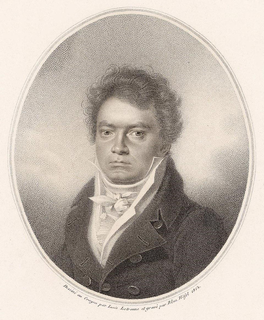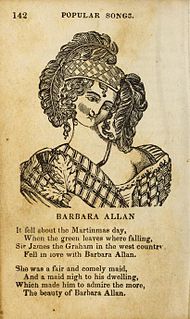Related Research Articles

The Symphony No. 7 in A major, Op. 92, is a symphony in four movements composed by Ludwig van Beethoven between 1811 and 1812, while improving his health in the Bohemian spa town of Teplitz. The work is dedicated to Count Moritz von Fries.

Bagatelle No. 25 in A minor for solo piano, commonly known as Für Elise, is one of Ludwig van Beethoven's most popular compositions. It was not published during his lifetime, only being discovered 40 years after his death, and may be termed either a Bagatelle or an Albumblatt. The identity of "Elise" is unknown; researchers have suggested Therese Malfatti, Elisabeth Röckel, or Elise Barensfeld.

"Barbara Allen" is a traditional folk song once popular throughout the English speaking world. It tells how the eponymous character denies a dying man's love then dies of grief soon after his untimely death.

"Auld Lang Syne" is a popular song, particularly in the English-speaking world. Traditionally it is sung to bid farewell to the old year at the stroke of midnight on New Year's Eve. By extension, it is also often heard at funerals, graduations, and as a farewell or ending to other occasions; for instance many branches of the Scouting movement use it to close jamborees and other functions.

George Thomson (1757–1851), born at Limekilns, Fife, Scotland, was a noted collector of the music of Scotland, a music publisher, and a friend of Robert Burns. He was clerk to the board of trustees in Edinburgh for 60 years. His A Select Collection of Original Scottish Airs for the Voice came out in six volumes between 1793 and 1841, and included contributions from Burns, Walter Scott and Thomas Campbell. Thomson published folksong arrangements by Joseph Haydn, Ludwig van Beethoven, Ignaz Pleyel, Leopold Kozeluch, Johann Nepomuk Hummel, Carl Maria von Weber, Henry Rowley Bishop, and Robert Archibald Smith.

Ludwig van Beethoven is one of the most influential figures in the history of classical music. Since his lifetime, when he was "universally accepted as the greatest living composer", Beethoven's music has remained among the most performed, discussed and reviewed. Scholarly journals are devoted to analysis of his life and work. He has been the subject of numerous biographies and monographs, and his music was the driving force behind the development of Schenkerian analysis. He is widely considered as among the most important composers, and along with Bach and Mozart, his music is the most frequently recorded.
"Garryowen", also known as "Garyowen", "Garry Owen" and "Gary Owens", is an Irish tune for a jig dance. It was selected as a marching tune for Australian, British, Canadian, and American military formations, including General George Armstrong Custer's 7th Cavalry Regiment and Australia's 2 Cav Regiment.
Pyotr Ilyich Tchaikovsky's String Quartet No. 1 in D major Op. 11 was the first of his three completed string quartets that were published during his lifetime. An earlier attempt had been abandoned after the first movement was completed.
"The Water Is Wide" is a folk song of Scottish origin. It remains popular in the 21st century. Cecil Sharp published the song in Folk Songs From Somerset (1906).

Ludwig van Beethoven's Piano Sonata No. 27 in E minor, Op. 90 was written in the summer of 1814 – Beethoven's late Middle period – and dedicated to Prince Moritz von Lichnowsky, a friend and benefactor who was also the dedicatee of the Eroica Variations.

The Piano Sonata No. 31 in A♭ major, Op. 110, by Ludwig van Beethoven was composed in 1821 and published in 1822. It is the middle piano sonata in the group of three that he wrote between 1820 and 1822, and the thirty-first and penultimate of his piano sonatas. Though the sonata was commissioned in 1820, Beethoven did not begin work on Op. 110 until the latter half of 1821, and final revisions were completed in early 1822. The delay was due to factors such as Beethoven's work on the Missa solemnis and his deteriorating health. The original edition was published by Schlesinger in Paris and Berlin in 1822 without dedication, and an English edition was published by Muzio Clementi in 1823.
"The Parting Glass" is a Scottish traditional song, often sung at the end of a gathering of friends. It has also long been sung in Ireland, enjoying considerable popularity to this day and strongly influencing the style in which it is often now sung. It was purportedly the most popular parting song sung in Scotland before Robert Burns wrote "Auld Lang Syne".
Album for the Young, Op. 68, was composed by Robert Schumann in 1848 for his three daughters. The album consists of a collection of 43 short works. Unlike the Kinderszenen, they are suitable to be played by children or beginners. The second part, starting at Nr. 19, is marked Für Erwachsenere and contains more demanding pieces.
Carl Gilbert Hardebeck or Carl G. Hardebec was an Irish composer and arranger of traditional music.

25 Scottish Songs was composed by Ludwig van Beethoven. The work was published in London and Edinburgh in 1818, and in Berlin in 1822. It is the only set among Beethoven's folksong arrangements to be assigned an opus number; the rest are only given WoO numbers.

Robert Burns, also known familiarly as Rabbie Burns, the NationalBard, Bard of Ayrshire, the Ploughman Poet and various other names and epithets, was a Scottish poet and lyricist. He is widely regarded as the national poet of Scotland and is celebrated worldwide. He is the best known of the poets who have written in the Scots language, although much of his writing is in a "light Scots dialect" of English, accessible to an audience beyond Scotland. He also wrote in standard English, and in these writings his political or civil commentary is often at its bluntest.
The Monks of the Screw was the name of an Irish drinking club active in the period 1779–1789. It was also called the Order of St. Patrick. The "screw" referred to the corkscrew required to open a bottle of wine.
References
- ↑ "Beethoven's Irish Songs". Beethoven's Irish Songs. Retrieved 25 May 2019.
- ↑ Cooper, Barry (1996). 'Beethoven’s Folksong Settings as Sources of Irish Folk Music' in Irish Musical Studies V. Dublin: Four Courts Press. p. 78.